A summary of yoga’s physical, mental and spiritual benefits, and a primer on the many lifestyle options that help you to achieve those benefits and, preferably, to share the benefits with others.
The Benefits of Yoga
Recognizing Yoga (oneness) offers physical, mental and spiritual benefits.
Among the physical benefits are, a stronger, more toned and more balanced body that is free of pain. In addition, yoga prevents and cures* innumerable diseases including stomach acid, cancer, heart problems, anaemia, appendicitis, arthritis, asthma, backache, high or low blood pressure, loss of memory, breathlessness, bronchitis, broncho-pneumonia, cold, cough, colic, colitis, constipation, coronary thrombosis, diabetes, diarrhea, dilation of heart, dysentery, dyspepsia, epilepsy, fatigue, flatulence, gastritis, gout, halitosis, insomnia, menstrual disorders, migraines, nervous debility, obesity, polio, paralysis, piles, pleurisy and pneumonia, rheumatic pains, sciatica, sterility, thrombosis of the legs, tonsilitis, tuberculosis, tumour of the stomach, gastric and duodenal ulcers and varicose veins. (Source: items listed in bold are from my own experience. Other conditions are listed in the book “Light on Yoga” by B.K.S. Iyengar. * A disease can be cured when its root cause is correctly identified and eliminated. Simply joining a yoga class is unlikely to give you this result. It is wise that you do search for the real cause of your imbalance/illness rather than simply masking symptoms. Welcome to discuss this with your doctor, too.) As for the mental benefits, yoga eliminates stress and leaves you relaxed so that you can live and sleep in peace. The final goal of yoga is the most profound benefit, that of recognizing our total union with God and all of creation. This union is already a given… but recognizing it fully will bring supreme lasting joy.
Yogis, instructors and masters
A yogi is someone that is searching to know himself more deeply, such that he is able to recognize the unity of body, mind, spirit and universe. An instructor is one that helps another in the search for this discovery of truth. Every yoga instructor is also a yogi or a seeker until the moment he attains the final goal, the moment that he becomes a yoga master. A yoga master is one that has attained the goal of total awareness of oneness with God and with the entire creation. A master then guides others towards the goal using old methods or new ones specially adapted to eliminate the specific blockages in the path of the individual. Although realized yoga masters are few and difficult to find, each one of us has a yoga master deep within ourselves.
The many paths of yoga (ways of becoming more aware of oneness)

Any method or system is called yoga when it helps a yogi to develop consciousness, such that he can better know his true essence, where his body, mind and spirit dance freely, and work together synergistically.
There are many known yoga systems for getting closer to the final goal. But it is always possible for someone to reach the final goal with or without a proven (old) system. The dedicated work in one’s self-invented system should be considered a “new yoga” from the moment of the achievement. The following fields and disciplines are some of the known (old) yoga systems:
Karma Yoga
Karma is the law of action/reaction. It is impossible to avoid karma because every action generates at least one reaction. Good actions lead to favourable reactions. Giving and receiving are inseparable. The yogi that gives unselfishly generates good karma. If you believe that your current situation is unfavourable, you may wish to analize the specific steps you took to get into that situation. Thinking about “past lives” is usually nothing more than a cop-out, which incorrectly blames the distant past thereby allowing the person to elude his or her direct responsibility for recent actions. It is foolish to speak of “having bad karma” without doing anything about it. More intelligent would be to trace your current position back just a few steps to determine the precise reason that you are now experiencing discomfort. This will surely help you avoid repeating those steps and hence the discomfort.
Bakti Yoga
Bakti means devotion (to God, to the Lord, or to one’s guru). Religious persons (of any religious belief) frequently practice bakti yoga, although they may not call it by this name. Devotion to a job, a boss, a partner or a child could (on rare occasions) be considered bakti yoga but only when the yogi fully recognizes the divine in the object of devotion.
Jnana Yoga
Jnana Yoga is yoga of the intellect, great for lawyers, judges, scientists, linguists and anyone that enjoys digging deeper into life, to examine its essence, and to find the appropriate words to explain that essence. In particular, one must differentiate between that which is real/eternal, and that which is merely a temporary manifestation. That which we observe through the five notorious senses falls into the second category.
Hatha Yoga
Ha-tha means “sun-moon”. Here, sun and moon are referred to, metaphorically, as polar opposites. (Of course, the moon is not really the opposite of the sun, but we get the image of a day-night continuum so the metaphor is somewhat useful.) Hatha Yoga is one of the newest of the proven (old) yoga systems. Its earliest document is from the 11th century, a yogi called Gorakh, who sometimes lived like a king and sometimes like an ascetic, two “opposite” ends of a social continuum. Today, most people use the term “Hatha Yoga” to refer to a system of bodily postures and breathing techniques to heal and balance the body, such that the (indivisible) bodymind becomes a “better” vehicle for the soul. Tirumalai Krishnamacharya (died in 1989), Pattabhi Jois and B.K.S. Iyengar are the prominent authors of this “modern” style of Hatha Yoga.

The asanas or postures at once stretch and strengthen all of the muscles and tissues while purifying them of toxins.
Hatha Yoga can be gentle or intense to adapt to the level of each individual. The practice implies the observation of both extremes of the duality of tension and relaxation. That is to say, that the yogi achieves the desired relaxation through the excercises that stretch and tense the muscules. The breathing exercises help the yogi to control her or his energy level since the air is charged with prana or pure energy that we can store for later use.
Ashtanga Yoga
Ashtanga Yoga is an eightfold path that includes the disciplines of hatha yoga (asana and pranayama), and six more disciplines: yama, niyama, pratyahara, darana, dhyana and samadhi.
- Yama means control or observation. When used by itself, it refers to observing the universe, in general. One can observe areas of “peace” and “non-peace” for example. We humans do love to categorize! We observe that peace is “better” than non-peace. This is a judgement. Despite the bad stigma that people often attach to this word, there is no reason to eliminate judgements altogether.
- Niyama is “control or observation towards oneself“. It refers to personal discipline, including hygiene and purifying the body and the mind by eliminating physical toxins and emotional toxins like hatred and pride, passion, anger, greed and delusion. The yogi observes that these emotions are useless and hurtful and replaces them with a greater dedication to that which brings wellbeing and happiness.
- Asanas are as mentioned in the section above, hatha yoga.
- Pranayamas are also as mentioned above.
- Pratyahara is the state that is achieved when one is no longer a slave to his or her five nototious senses, namely, touch, sight, hearing, smell and taste. These normally dominate us through their frequent requests and complaints. The pleasure that we receive through these five senses is temporary and therefore these senses represent traps in the path towards perpetual joy. (The sixth sense, intuition, does not require disconnecting.) The yogi finds within himself a joy to which he or she always has access, including when the five senses would otherwise signal a lacking.
- Darana – concentration. This can be used as a “platform”, from which one can more easily “climb” to a state of meditation.
- Dhyana – meditation. Meditation more closely resembles “observation” than “relaxation” although there are many meditacion groups that focus on the latter.
- Samadhi – superconsciousness achieved through profound meditation.
Kundalini Yoga
Kundalini Yoga is a system to awaken and to raise the energy up along the spinal column. The practitioner feels a strong and unique sensation each time the energy bursts through another chakra (imagine an orgasm in the heart!). The chakras are energy wheels, similar to the roundabouts that connect several high-traffic city streets. The energy spins around instead of stopping and starting, as at a traffic light.
Tantra Yoga
Tantra is the highest form of cultivating the energy within for its healing effects on the self and others. In Kundalini Yoga, the healing energy is awakened and circulated. In Tantra Yoga, the healing energy is multiplied and transformed into all other energies. Tantra is often marketed as a sexual practice. This is an aberration to say the least. While learning Tantra Yoga will undeniably help your love life in countless ways, you’ll find even more benefits in all other areas of your life. And, although yoga is essentially about “uniting”, there are many Tantra practices that can be practiced even without a partner.
Where to practice yoga, and with whom?
You can practice yoga (oneness) on your own at any time, without the need of an instructor. Oneness is your essence, and the essence of the entire universe. Therefore you needn’t go anywhere to find an example of oneness. If you want to practice physical postures, there are yoga schools on almost every street corner in many parts of the world (USA and Canada, for example), and in other countries where yoga schools are not so ubiquitous, there are still several options. These schools will likely focus almost entirely on physical posture and breath. To enjoy the class, fully, understand where most teachers and students are coming from… it is decidedly unwise to challenge them on any concepts mentioned during the scheduled class. Despite a general view that yogis tend to be “open-minded”, the reverse is often the case when a learned yogi is challenged on his acquired knowledge. If you are inclined to challenge someone, please challenge someone that will not be offended by this. Like me, for example. If you have a partner or a group, you can share the experience and benefits of yoga, by practicing partner yoga. Posing together is not only an artistic thing to do, it also provides additional support and challenges in a way that increases the benefits for all involved.


